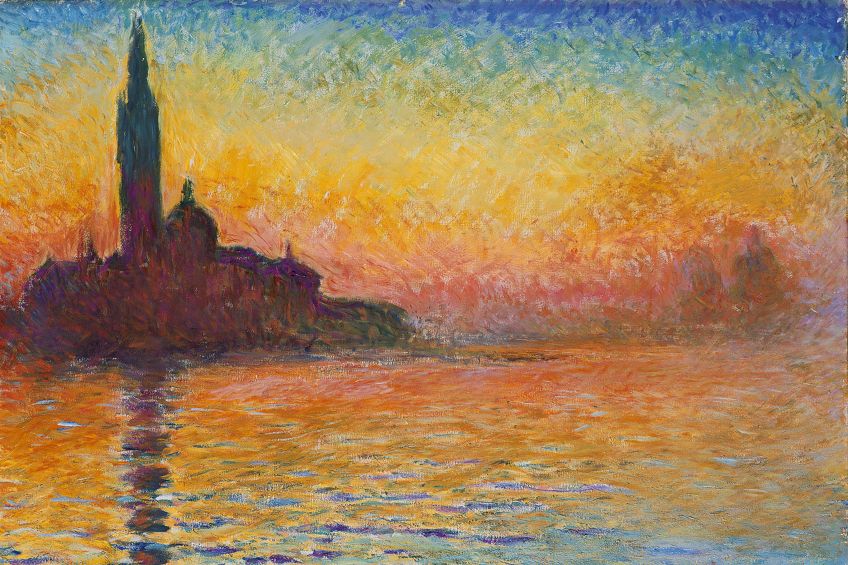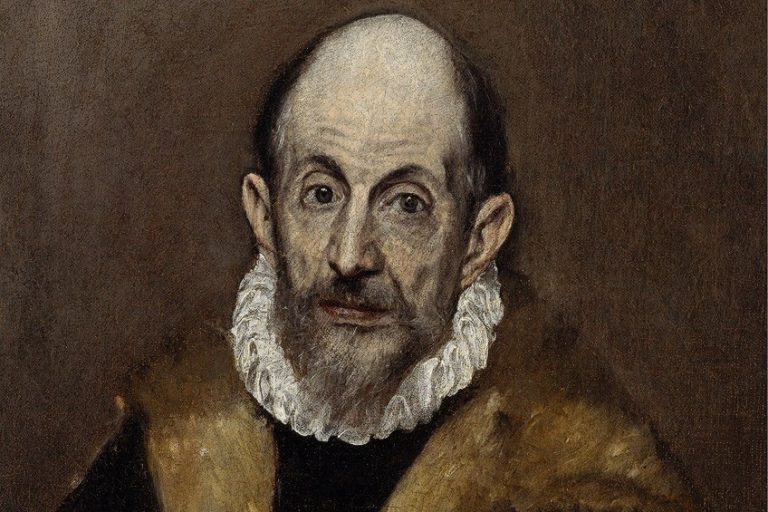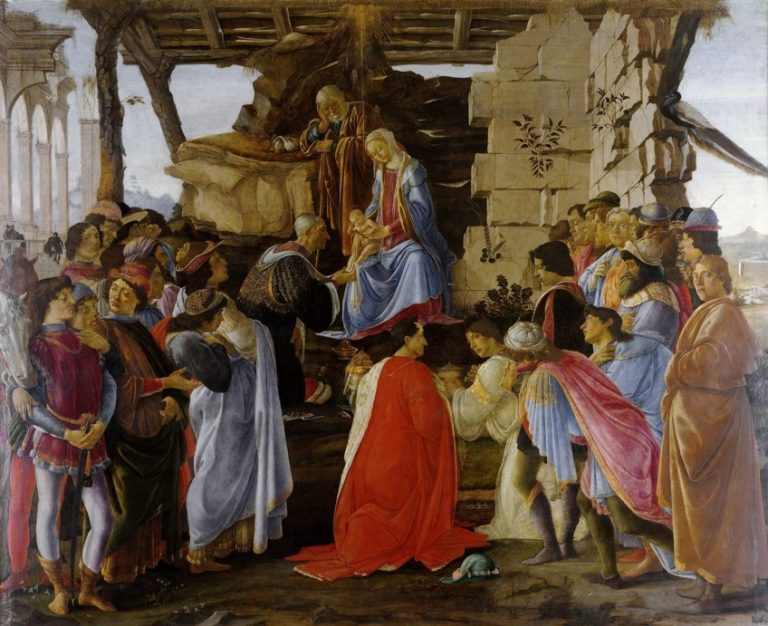Famous Paintings of Sunsets – Capturing the Setting Sun
Why would an artist choose to produce a painting of a sunset? A magnificent sunset, many people would say, is among the most stunning views you can witness. The blending of hues as dusk falls may be tranquil and soothing, and the warm yellows, vivid reds, and flaming oranges in the scene all catch the attention of the eye and comfort the spirit. Therefore, you might not find it surprising how many famous sunset paintings have been created with the aim of transferring the experience to the canvas.
Famous Sunset Paintings
Artists chose to exhibit the concept of reality, its impression, instead of a literal representation, with the creation of Impressionism. This opened up a world of possibilities for artists involved with landscape art, particularly the en plein air style. One can determine from the choice of color what the day was like when the artist created his painting of a sunset, what emotions passed through him, and how he perceived the world at that moment. Here is our choice of famous sunset paintings that capture both the location the artist was trying to depict, as well as the state of mind the artist was in when he created the painting of a sunset.
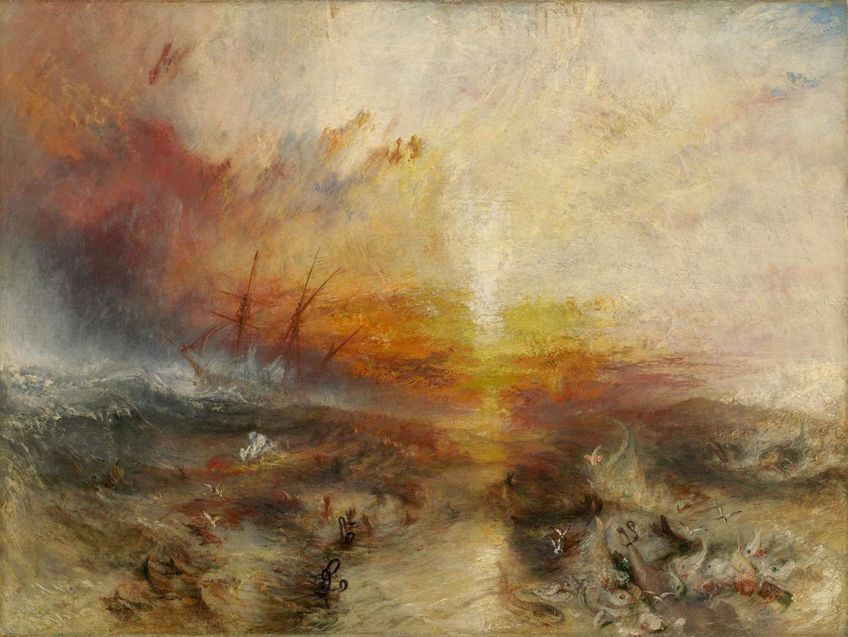
Evening Landscape with Two Men (1835) by Caspar David Friedrich
| Artist | Caspar David Friedrich (1774 – 1840) |
| Date Completed | 1835 |
| Medium | Oil on canvas |
| Dimensions (cm) | 25 x 31 |
| Current Location | Hermitage Museum, Saint Petersburg, Russia |
Caspar David Friedrich, one of the most prominent German artists of the 18th and 19th centuries, is recognized for his ability to produce beautiful landscapes. Evening Landscape with Two Men is one of the artist’s most renowned sunset artworks. This piece, created in the Romantic style, depicts two men, maybe brothers, dressed in hats and long robes staring at the sunset with their backs to the viewer. In the backdrop, the sun appears to have already set behind a mountain peak. This painting of a sunset’s general color scheme is a blend of dark and orange colors, which works perfectly in this particular instance. Furthermore, there is no noticeable vegetation in the image to detract from the light’s impact or viewers from admiring the magnificent silhouetted sunset.

Sunset Calm in the Bay of Fundy (1860) by William Bradford
| Artist | William Bradford (1823 – 1892) |
| Date Completed | 1860 |
| Medium | Oil on board |
| Dimensions (cm) | 33 x 48 |
| Current Location | Private collection |
Bradford began his career as a prolific ship portraitist, selling pictures to ship owners as well as shipmasters. Bradford’s maiden journey from Cape Cod to the Bay of Fundy took place in July 1856. In 1860, the artist came back on a returning ship. This 1860 piece portrays fishermen gathering the rest of the day’s catch beneath a bright sunset sky. Bradford’s grasp of light and detail is evident in this painting. Every detail of the scene has been meticulously created by the artist. The lines, masts, and hulls of the vessels are all painstakingly painted, as are the fishermen pulling at the lines.
The artist has captured the fishermen in action, taking care to depict each figure’s clothes.
The artist also depicted vessels that are barely visible on the horizon, each mirrored in the bay’s tranquil water. The sun is low on the horizon, turning the sky from blues to gold to oranges and bouncing a dazzling yellow off of the sea. As the sun sets, there is a sense of a long day coming to an end—the radiant light is ready to fade beyond the horizon, bathing the quiet bay and the fishermen who are hauling up their last lines in its radiance.
Twilight: Mount Desert Island, Maine (1865) by Frederic Edwin Church
| Artist | Frederic Edwin Church (1826 – 1900) |
| Date Completed | 1865 |
| Medium | Oil on canvas |
| Dimensions (cm) | 31 x 48 |
| Current Location | Kemper Art Museum, Kansas City, USA |
Frederic Edwin Church created huge, spacious paintings with accurate geographical detail that emphasized nature’s tremendous force. This artwork’s brilliant crimson sky reveals the inherent drama contained in such a commonplace occurrence as the lowering of the sun. The departing light of the early evening sky, framed by the stretch of rocky shoreline and coniferous trees, provides a tone of finality and even fatigue, which is connected with certain events of the period on both personal and national levels for the painter.
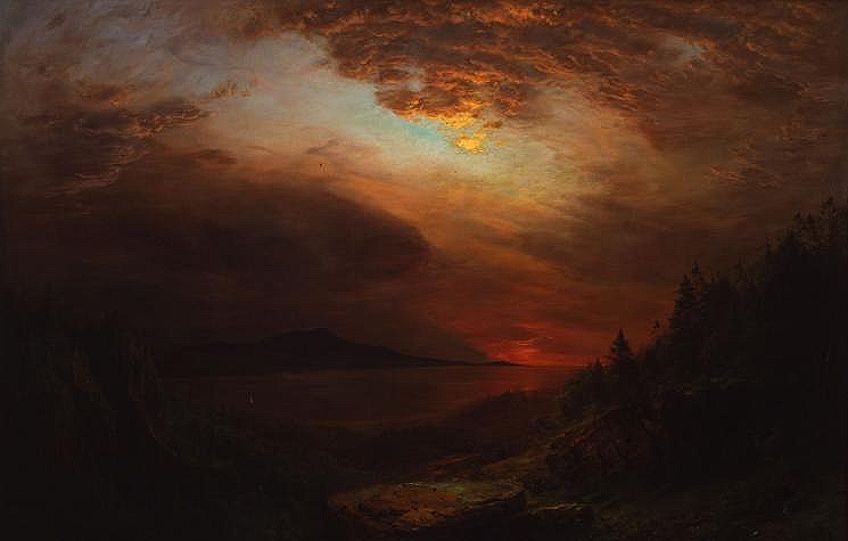
In 1865, the Civil War was finally coming to an end, leaving Americans with severe scars of both physical torment and psychological anguish, and Church suffered a tragic loss when both his daughter and son died of diphtheria that year. The panoramic vista offers a majestic encounter with the mountainous setting, prompting viewers to explore deeper connotations such as the feeling of an ending, and the conclusion of an era in American history. The deer on the side, near the stream, provides a symbolic counterpoint to the main subject of the image, symbolizing a rebirth of life even as sunlight fades.
Sunset in the Rockies (1866) by Albert Bierstadt
| Artist | Albert Bierstadt (1830 – 1902) |
| Date Completed | 1866 |
| Medium | Oil painting |
| Dimensions (cm) | 66 x 91 |
| Current Location | Private collection |
When it comes to making magnificent sunset paintings, Albert Bierstadt is a well-known name. Sunset in the Rockies is one of the artist’s works that demonstrates his unique ability to capture scenes that reflect the raw beauty of nature – which is just magnificent. A river is depicted in the foreground of this artwork, surrounded by tall and lush flora that reflects the departing sunlight. The Rocky Mountains may be seen in the background, hidden behind the gloomy sky. The entire panorama is delightfully lit by the golden color of the gorgeous sunset.
When it was originally shown in eastern America, the artwork received a lot of positive feedback from the art community and the masterwork remains one of Albert Bierstadt’s most recognizable works.
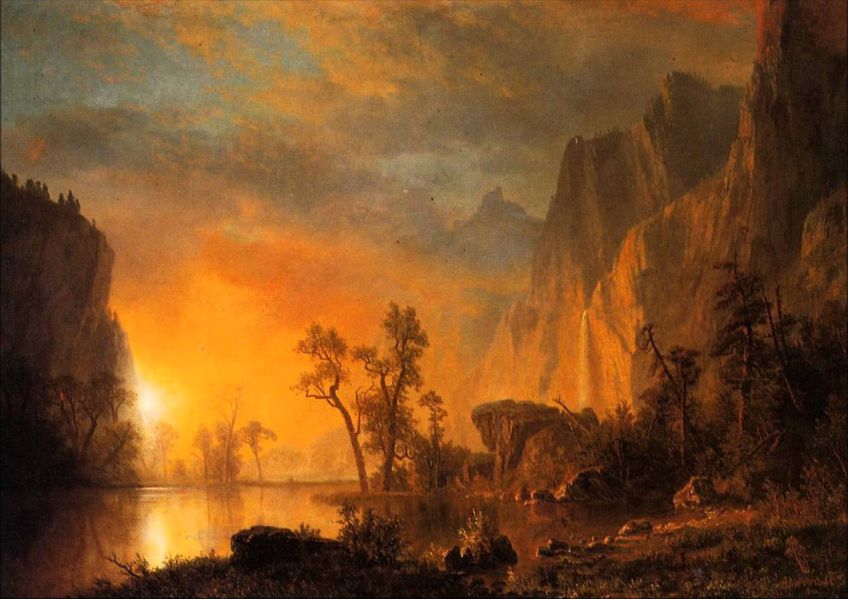
Sunset Fires (1880) by Winslow Homer
| Artist | Winslow Homer (1836 – 1910) |
| Date Completed | 1880 |
| Medium | Watercolor painting |
| Dimensions (cm) | 24 x 34 |
| Current Location | Westmoreland Museum of American Art, Pennsylvania, USA |
This tiny picture may not be among the painter’s most renowned, but it is significant since it foreshadowed Homer’s artistic path in the following years. After dabbling in various genres in earlier decades, he would commit himself to seascapes in the 1880s. He began as an illustrator before studying the methods of oil painting and then watercolors. He liked the American countryside and promoted its beauty via several artworks throughout his career. He included human beings in some of these portrayals, while in others he let nature take center stage.

With the incorporation of sailors within a boat and a smaller vessel that head out to our right, we discover a combination of mankind and nature in this painting. We also can also observe a horizontal stretch of lake or sea, as well as a flurry of gray and blue paint that completes the skies above. The lack of detail suggests that this painting of a sunset was done in a relatively short amount of time and may have been viewed as more of a study work.
The Red Vineyard (1888) by Vincent van Gogh
| Artist | Vincent van Gogh (1853 – 1890) |
| Date Completed | 1888 |
| Medium | Oil on canvas |
| Dimensions (cm) | 75 x 93 |
| Current Location | The Pushkin State Museum of Fine Arts, Moscow, Russia |
In October 1888, Gauguin came to Arles and lived with Van Gogh, who was overjoyed at the prospect of establishing, if not an artists’ colony, at least a shared studio. The two artists had worked on comparable projects, and Gauguin’s impact is evident in Van Gogh’s works from this period. Van Gogh was particularly taken by a nearby vineyard, whose colors were changing to fall’s yellows and reds as the days became shorter, especially around sunset. He caught the mellowed tones and sparkling light of the setting sun reflected in the river, while Gauguin portrayed ladies in the traditional Breton clothing of his country in his rendition of the same scene.
Van Gogh was not present in front of the vineyard when he painted it; he created it at the Yellow House entirely from imagination and memory the day after walking through a neighboring wine plantation.
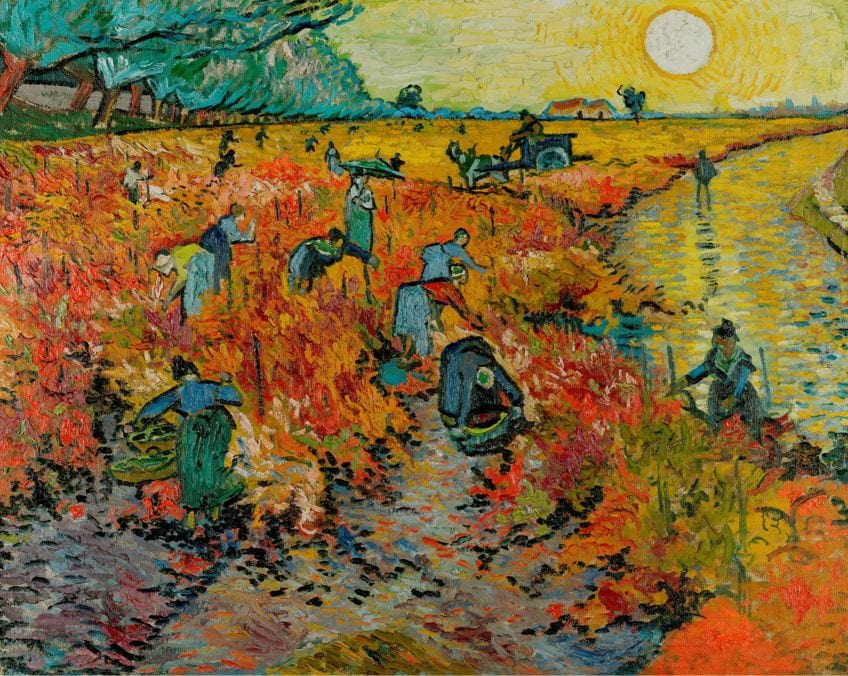
Sunset at Eragny (1890) by Camille Pissarro
| Artist | Camille Pissarro (1830 – 1903) |
| Date Completed | 1890 |
| Medium | Oil on canvas |
| Dimensions (cm) | 65 x 81 |
| Current Location | Israel Museum, Jerusalem, Israel |
This painting by Pissarro is one of the French Impressionist’s greatest, depicting a stunning representation of the sunset in purples and yellows. Pissarro was an adventurous painter who tried out a number of painting methods to depict a variety of landscapes based on how the sun’s light transformed the hues and altered natural colors. The artist succeeded to capture the spirit of a sunset in this picture by focusing on the brilliance of the sunlight and how this intensity influenced the magnificence of the landscape and skies. Pissarro’s objective was to depict a scene of the sunset as it was ready to fade away.

Despite the fact that the artwork is made up of only a few simple elements, it is a lively painting. A couple of rows of trees, one somewhat further back, are separated into four groups that span the full image plane. The land dips down behind them, then climbs again to greet the sky along a low horizon. The sky is depicted in light pastel tones, with the captivating setting sun at its center. This white-hot sphere is surrounded by fragmented swirls of clouds, through which blue sky streaks appear. The golden glow of the setting sun lights the fields but casts dark green shadows on the part of the trees facing the viewer.
San Giorgio Maggiore at Dusk (1912) by Claude Monet
| Artist | Claude Monet (1840 – 1926) |
| Date Completed | 1912 |
| Medium | Oil on canvas |
| Dimensions (cm) | 65 x 92 |
| Current Location | National Museum Cardiff, Cardiff, Wales, UK |
Starting in 1908, Claude Monet made a sequence of paintings highlighting the monastery of San Giorgio Maggiore near Venice. This artwork, named San Giorgio Maggiore at Dusk, is one of the artist’s most well-known works. The artist depicts a sun setting in the darkening sky in the painting. The city in the distance is plunged into the shadows while being encircled by brilliant colors, giving the artwork intriguing and striking contrast.
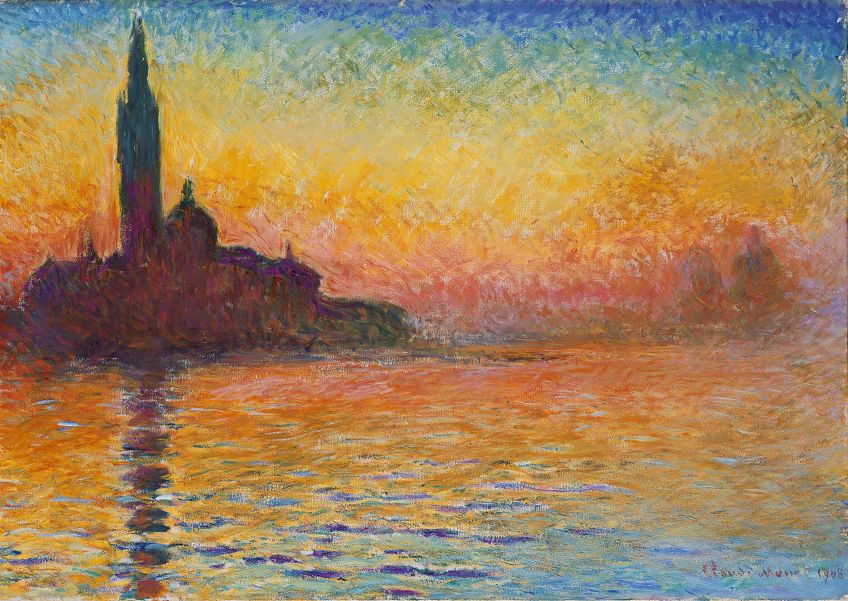
The influences of light are important to Monet’s representation of an Italian monastery. Monet believed Venice was “too magnificent to paint”, which may explain why he returned to Giverny, his birthplace in France, with many paintings incomplete. He had, though, already abandoned his old habit of working from life, directly in front of the scene. At home, he worked on the Venetian scenes, and the passing of his wife in 1911 appears to have influenced their completion.
Sunset, Long Island (1939) by Georgia O’Keeffe
| Artist | Georgia O’Keeffe (1887 – 1986) |
| Date Completed | 1939 |
| Medium | Oil on canvasboard |
| Dimensions (cm) | 25 x 36 |
| Current Location | Amon Carter Museum of Modern Art, Fort Worth, Texas, USA |
Georgia O’Keeffe, regarded as the Mother of Modernism in America is most known for her works of New York skyscrapers, magnified flowers, and New Mexican landscapes. One of her primary aims was to abstract the natural environment in an attempt to make it more alluring, and her work is often identified with the development of abstract landscapes.
This is the case with this painting which depicts the sinking sun lowering into the water of the Hudson River using basic and flat, nearly monochrome surfaces.
Northern Sunset (1988) by David Hockney
| Artist | David Hockney (1937 – Present) |
| Date Completed | 1988 |
| Medium | Oil on canvas |
| Dimensions (cm) | 91 x 122 |
| Current Location | Museum of Modern Art, New York, USA |
David Hockney, another artist interested in abstracting nature, depicts an unusually extravagant rendition of the midnight sun in Norway. Despite the frigid location, this painting of a sunset exudes the warmth of the sun and its spectacular entry into the deep blue lake.
This painting, along with other works that show off Hockney’s strangely colorful and huge vistas, is perhaps the centerpiece of his oeuvre.
David Hockney, widely regarded as one of the most prominent British painters of the 20th century, constantly welcomed the changes in subject matter and style that his work forced upon him, and as such was always encouraging freedom and uniqueness.
With that, we conclude our list of famous sunset paintings. Each painting of a sunset on this list showcases how various artists take on the same subject matter in such unique ways. From more naturalistic to Impressionistic works, and even abstract landscapes, sunsets have long captured the hearts of both artists and art lovers alike.
Take a look at our sunset paintings webstory here!
Frequently Asked Questions
Why Do Artists Create Sunset Artworks?
Sunsets are great for artists to practice their various skills at color blending and the ability to portray nature. Each artist also adds their own unique interpretation of how they view the sunset’s colors. We can often even catch a glimpse of the artist’s headspace when he produced the painting.
Why Are Most Sunset Paintings at the Ocean?
The ocean is always the best place to view the sunset before it sinks below the horizon. The water surface also reflects the colors of the sunset, which is something artists love to try and capture. Sunsets are part of landscape art, which has always been popular among painters.
Isabella studied at the University of Cape Town in South Africa and graduated with a Bachelor of Arts majoring in English Literature & Language and Psychology. Throughout her undergraduate years, she took Art History as an additional subject and absolutely loved it. Building on from her art history knowledge that began in high school, art has always been a particular area of fascination for her. From learning about artworks previously unknown to her, or sharpening her existing understanding of specific works, the ability to continue learning within this interesting sphere excites her greatly.
Her focal points of interest in art history encompass profiling specific artists and art movements, as it is these areas where she is able to really dig deep into the rich narrative of the art world. Additionally, she particularly enjoys exploring the different artistic styles of the 20th century, as well as the important impact that female artists have had on the development of art history.
Learn more about Isabella Meyer and the Art in Context Team.
Cite this Article
Isabella, Meyer, “Famous Paintings of Sunsets – Capturing the Setting Sun.” Art in Context. January 27, 2023. URL: https://artincontext.org/famous-paintings-of-sunsets/
Meyer, I. (2023, 27 January). Famous Paintings of Sunsets – Capturing the Setting Sun. Art in Context. https://artincontext.org/famous-paintings-of-sunsets/
Meyer, Isabella. “Famous Paintings of Sunsets – Capturing the Setting Sun.” Art in Context, January 27, 2023. https://artincontext.org/famous-paintings-of-sunsets/.


